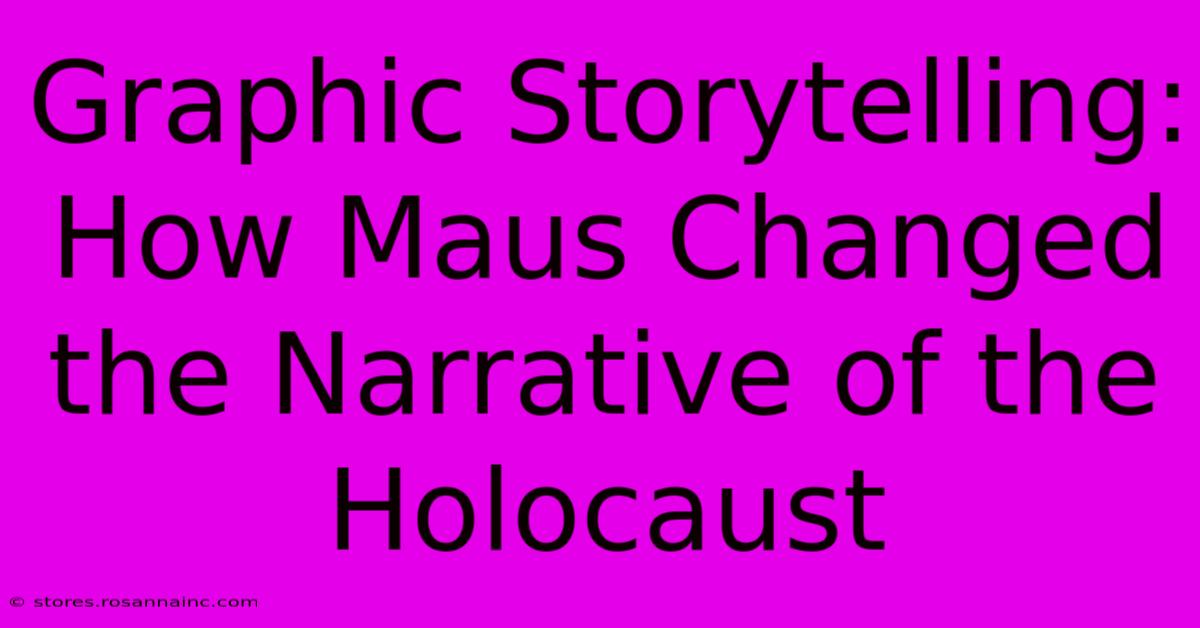Graphic Storytelling: How Maus Changed The Narrative Of The Holocaust

Table of Contents
Graphic Storytelling: How Maus Changed the Narrative of the Holocaust
Art Spiegelman's Maus isn't just a graphic novel; it's a seismic shift in how we understand and engage with historical trauma. Published serially in the 1980s and collected into a single volume, Maus revolutionized graphic storytelling, proving its power to convey complex and emotionally charged narratives with unprecedented impact. This exploration delves into how Maus fundamentally altered the narrative of the Holocaust, transcending the limitations of traditional historical accounts.
Beyond Words: The Power of Visual Narrative
Before Maus, the Holocaust was largely depicted through somber photographs, stark documentary footage, and weighty historical texts. While powerful in their own right, these mediums often struggled to capture the visceral experience of the Holocaust, the sheer terror and dehumanization inherent in the Nazi regime. Spiegelman, however, brilliantly utilizes the graphic novel format to bridge this gap.
Animalistic Metaphors and Human Emotion
Maus's most striking innovation is its anthropomorphic approach. Jews are depicted as mice, Germans as cats, Poles as pigs, and Americans as dogs. This seemingly simple choice is far from simplistic. The animalistic representation isn't a trivialization; rather, it serves to both distance and highlight the dehumanization experienced by the Jews. It allows Spiegelman to explore the psychological impact of the Holocaust in a way that traditional narratives often couldn't. The animal metaphors create a unique visual language that speaks to both the absurdity and the horror of the situation.
The Interplay of Past and Present
Maus isn't simply a retelling of historical events; it's a deeply personal and layered narrative. The story unfolds through Spiegelman's interviews with his father, Vladek, a Holocaust survivor. This intergenerational dialogue, depicted visually through distinct panels and art styles, creates a compelling tension between the past and the present. We see the impact of the Holocaust on Vladek's life and on his relationship with his son, adding emotional depth and complexity to the historical account. The fractured memories, the silences, and the uneasy conversations are all powerfully rendered through the visual medium.
Breaking Down Barriers: Accessibility and Emotional Impact
Maus’s accessibility played a crucial role in its success. The graphic novel format, often perceived as a more accessible medium than dense historical texts, allowed a wider audience to engage with the Holocaust's narrative. The visual storytelling transcends language barriers, making it relatable to a global audience. The combination of words and images fosters a deeper emotional connection, allowing readers to experience the trauma, the resilience, and the enduring legacy of the Holocaust in a profoundly personal way.
A New Standard for Graphic Novels
Maus didn't just tell a story; it set a new standard for the graphic novel genre. Its sophisticated use of visual metaphors, its exploration of complex themes, and its compelling narrative structure proved that comics could be a powerful vehicle for serious literature. It paved the way for countless other graphic novels tackling sensitive and challenging historical events, proving the versatility and impact of the form.
The Lasting Legacy of Maus
The lasting legacy of Maus is undeniable. Its impact on the understanding and representation of the Holocaust is immeasurable. It brought the personal stories of survivors into the mainstream, offering a human face to the unimaginable horrors of the past. It challenged conventional historical narratives and established the graphic novel as a legitimate form of historical storytelling. Maus remains a testament to the power of art to confront difficult histories and to foster empathy and understanding. It continues to inspire and educate readers, ensuring that the lessons of the Holocaust are never forgotten.
Keywords: Maus, Art Spiegelman, Holocaust, graphic novel, graphic storytelling, historical trauma, visual narrative, anthropomorphism, intergenerational trauma, accessibility, comic books, literature, historical fiction, memory, trauma, storytelling, narrative techniques, Holocaust survivor, Vladek Spiegelman.

Thank you for visiting our website wich cover about Graphic Storytelling: How Maus Changed The Narrative Of The Holocaust. We hope the information provided has been useful to you. Feel free to contact us if you have any questions or need further assistance. See you next time and dont miss to bookmark.
Featured Posts
-
De Jean Turns 22 Super Bowl Festivities
Feb 10, 2025
-
Unveiling The Fleshlight Everything You Ve Been Curious About
Feb 10, 2025
-
Eagles Vs Chiefs Super Bowl 2025 Online
Feb 10, 2025
-
Super Bowl 2024 Kickoff Time Plan Your Day Now
Feb 10, 2025
-
Jeremy Irons In Die Hard Unraveling The Mystery
Feb 10, 2025
